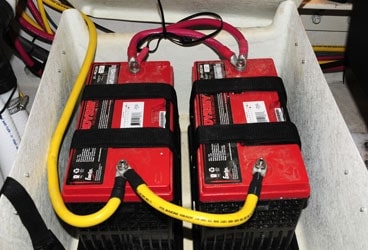
juice for the job 368
Many of the sailboats that I inspect during my work as a technical consultant have one thing in common: The output of the available charging sources is disproportionately small when compared to the capacity of the house battery bank.
Many of the sailboats that I inspect during my work as a technical consultant have one thing in common: The output of the available charging sources is disproportionately small when compared to the capacity of the house battery bank.
This lack of recharging capability indicates that a builder, a boatyard, or an owner has taken an unwitting piecemeal approach to managing the DC energy system, and it causes no end of frustration and disappointment for the folks cruising aboard these vessels. To make matters worse, because onboard energy needs have increased dramatically in the past decade, the size or capacity of house battery banks has grown dramatically in that time. Regrettably, those installing additional batteries are often unaware of the charging requirements for such a large house bank and of the consequences of failing to provide for the bank’s charging needs.
The rule of thumb for matching charge output to battery-bank size once called for an alternator with an output that was no less than 25 percent of the battery bank’s amp-hour capacity. Using this as a guideline, a 400-amp-hour battery bank would best be served by a 100-amp (or larger) alternator. The 25-percent rule was derived from the fact that the maximum approximate charge acceptance rate, or CAR, of a flooded-cell deep-cycle battery is roughly 25 percent of its amp-hour capacity during the initial bulk-charge stage. Any more output and the battery wouldn’t be able to accept it, and any less would equate to longer charging periods.
Today, with the advent of gel-cell and absorbent glass mat, or AGM, batteries, the CAR is as high as 100 percent of the bank’s amp-hour capacity. And in the case of thin-plate, pure-lead batteries, also known as TPPL AGMs, the acceptance rate can be well in excess of 100 percent of the battery’s CAR.
Thus, the design of a modern battery bank is primarily driven by three factors: the needs of the vessel’s house loads for a given period of time, say 24 hours; the desired recharge time (AGMs and gel-cells can be recharged more quickly than flooded batteries); and, to avoid chronic undercharging, the ability to replace completely the amp-hours that have been used.
Depending upon the vessel, house loads can range from a modest 100 amp-hours for a boat with few electrical amenities to 400 amp-hours for more energy-intensive platforms. If the house needs are greater than the bank can supply, simply adding batteries to the equation results in a short-lived solution; if the bank can’t be recharged in a reasonable amount of time, then it will suffer from chronic undercharging. This will lead, in addition to a frustrated user, to decreased battery life.
Too often I find that the stock alternator and regulator fail to provide an efficient, adequate charge, regardless of battery style or bank size. Typically, stock alternators, regardless of output capacity, are designed to recharge starting batteries rather than large, deep-cycle house batteries. Bear in mind, however, that the average engine start requires less than 1 amp-hour, a mere fraction of the aforementioned 24-hour average house usage. House battery banks must be designed in conjunction with their ability to be recharged from an appropriately sized, externally regulated alternator.
Steve D’Antonio offers services for boat owners and buyers through Steve D’Antonio Marine Consulting (www.stevedmarineconsulting.com).








